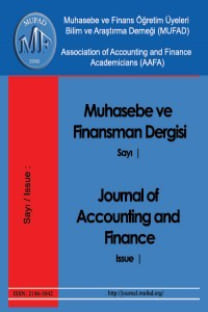Türkiye'de devlet iç borçlanma senetleri reel faizinin süreğenliği: Parametrik olmayan bir uygulama
The persistence of real ınterest of government domestic debt securities in Turkey: A nonparametric application
___
- Andrews, Donald,W.K. - Chen, Hong Y. (1994), Approximately median-unbiased estimation of autoregressive models, Journal of Business and Economic Statistics, No. 12, pp. 187204.
- Belbute, Jose Manuel Caleiro, Antonio. (2013), Cross Country Evidence on Consumption Persistence, International Journal of Latest Trends in Finance and Economic Science, Vol.3, No2, pp. 440-455.
- Caleiro Antonio. (2012), Output Persistence in Portugal, International Journal of Latest Trends in Finance and Economic Science, Vol.2, No3, pp. 206-210.
- Sonali, Das - Rangan, Gupta Patrick, T. Kanda- Monique, Reid Christian, K. Tipoy- Mulatu, F. Zerihun. (2012), Real Interest Rate Persistence in South Africa: Evidence and Implications Economic Change and Resturucting, December,2012.
- Dias Daniel - Marques Carlos Robalo. (2010), Using Mean Reversion As a Measure of Persistence, Economic Modelling, No. 27, pp. 262-273.
- Diebold, Francis Inoue, Atsushi. (2001), Long Memory and Regime Switching, Journal of Econometrics, No. 105, pp. 131-159.
- Gil Alana, Luis. (2004), Modelling the US real GNP with fractionally integrated techniques, Applied Economics, Vol. 36, No. 8, pp. 873-879.
- Gil-Alana, Luis Moreno, Antonio. (2012) Fractional integration and structural breaks in U.S. macro dynamics, Empirical Economics, Vol. 43, Np. 1, pp. 427-446.
- Kiefer, Nicholas M. Vogelsang, Timothy. (2002), Heteroskedasticity-Autocorrelation Robust Standard Errors Using The Bartlett Kernel Without Truncation, Econometrica, Vol. 70, No. 5, pp. 2093-2095.
- Kutlar, Aziz - Turgut, Tuba. (2006), Türkiyedeki Baş lıca Ekonomi Serilerinin ARFIMA Modelleri ile Tahmini ve Öngörülebilirliği, Kocaeli Üniversitesi Sosyal Bilimler Enstitüsü Dergisi, Cilt 11, Sayı 1, ss. 120-149.
- Lai, Kon, S. (1997), Long-term Persistence in the Real Interest Rate: Some Evidence of a Fractional Unit Root, International Journal of Finance and Economics, Vol. 2, No. 3, pp. 225-235.
- Marques, Carlos Robalo. (2004), Inflation Persistence: Facts or Artefacts Europan Central Bank Working Paper Series, No 371, June.
- Mishkin, Frederic S.. (2007), Inflation Dynamics, International Finance, Vol. 10, No. 3, pp. 317-334.
- Neely, Christopher J. - Rapach, David E. (2008), Real Interest Rate Persistence: Evidence and Implications, Federal Reserve Bank of St. Louis Review, Vol. 90, No. 6, No. 609-41.
- Rose, Andrew K. (1988), Is the Real Interest Rate Stable?, The Journal of Finance, Vol. 43, No. 5, pp. 1095-1112.
- Rotenberg, Julio Woodford, Michael. (1997), An Optimization Based Econometric Framework for he Evoluation of Monetary Policy : NBER Macroeconomics Annual 1997, Vol. 12, pp. 297-361.
- Svensson, Lars E. O. (1997), Optimal Inflation Targets, Conservative Central Banks and Linear Inflation Contracts, American Economic Review, Vol. 87, No. 98-114.
- Tsay Wen Jen, (2000), Long memory story of the real interest rate, Economics Letters, Elsevier, Vol. 67, No. 3, pp. 325-330.
- Turgutlu, Evrim. (2004), Fisher Hipotezinin Tutarlılığının Testi: Parçalı Durağanlık ve Parçalı Koentegrasyon Analizi, DEÜ İİ BF Dergisi, Cilt 19, Sayı. 2, ss. 55-74.
- Yurttagüler, İ pek M. Kutlu, Sinem. (2013), Reel Faiz Oranının Uzun Hafıza Modeli ile İ ncelenmesi: Türkiye Örneği, Maliye Dergisi, Sayı 164, Ocak Haziran, ss. 208-219.
- ISSN: 2146-3042
- Yayın Aralığı: 4
- Başlangıç: 2005
- Yayıncı: Muhasebe ve Finansman Öğretim Üyeleri Derneği (MUFAD)
Türkiye'de muhasebe alanında yapılan lisansüstü tez çalışmaları üzerine bir araştırma (1984-2012)
Türkiye'de devlet iç borçlanma senetleri reel faizinin süreğenliği: Parametrik olmayan bir uygulama
Işıl EREM, Fatma AKCANLI, Erhan GENÇ, Nezih TAYYAR
Sukuk as a new financial ınstruments: Types, application and taxation of Turkey
The geography of borsa Istanbul stock returns
How do business strategies predict firm performance? aninvestigation on borsa Istanbul 100 index
